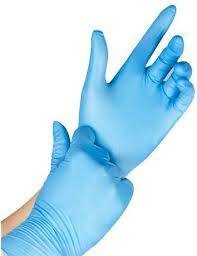
Gloves
Have you seen the increase in the number of individuals wearing disposable gloves in public? Gloves do create a barrier between the skin and touched surfaces, but they are only a barrier as strong as the glove. No matter the type of disposable gloves (vinyl, Nitrile, latex) used; gloves are not a substitute for handwashing!
Disposable Gloves
Disposable gloves have been used by healthcare professionals as a barrier to blood and bodily fluids; and became a standard known as Universal Precautions, once it was discovered how HIV was spread. One of the key pieces of information to remember is that gloves are not “perfect”. They may become torn or develop micro-punctures during use that are not easily seen. Gloves wear out. The use of gloves is not a substitute for handwashing.
For the best protection, use the right sized glove. A Cinderella fit is needed; a glove that is “too big” will slide on your hand and make it harder to grip things. A glove that is “too small” may not stretch sufficiently or tear during use. No matter what glove you use, gloves are not a substitute for handwashing. Handwashing should always be done after glove removal.

Putting On Gloves
- Wash your hands well with soap and rinse them with clean, running water. Then dry them well
- Hold the glove (open end) in one hand, and put your other hand into the glove
- Repeat with your other hand
Removing Gloves
There is an art to removing disposable gloves to minimize the chance of spreading germs to yourself and others. When you take gloves off, make sure the outsides of the gloves do not touch your bare hands. Follow these steps: If you are right-handed (if you are left-handed, reverse the steps)
- Grab the open end of your right glove with your left hand
- Pull toward your fingertips. The glove will turn inside out
- Hold onto the empty glove with your left hand
- Put 2 right-hand fingers in the opening of your left glove
- Pull toward your fingertips until you have pulled the glove inside out and off your hand. The right glove will be inside the left glove now
- Throw the gloves away in a waste container
- Wash your hands well with soap and rinse them with clean, running water. Then dry them well
Wearing Gloves In Public
I have watched people using gloves in the supermarket, walking, and while performing a variety of different tasks that do not typically require gloves. The use of gloves can provide a false sense of protection. I have seen individuals with gloves touching their face, and doing things that they would not consider doing without the gloves. Undamaged gloves do offer protection, as long as it is the right type of glove for the job. Do not assume that your gloves are “made of steel” and will never damage. No matter what, gloves are not a substitute for handwashing.
Allergies
Some individuals develop or have allergies to latex (made from rubber). These allergies tend to become more severe with repeated exposure. It is very important that you wash your hands and any bodily surface that may have come in contact with the latex. Monitor your symptoms; seek emergency assistance if you experience any difficulty breathing. Be sure to wear your latex allergy identification bracelet. It is vital that you share this with individuals who may touch you wearing disposable gloves. Verify that latex gloves are not being used in your care.

What To Do
- Seriously consider if you need to use gloves for the task at hand
- Never reuse disposable gloves
- If you have a supply of disposable gloves that could be donated for the care of patients, please do so. Caregivers and healthcare workers do not have the needed supply of gloves
- Wash your hands frequently – gloves are not a substitute for handwashing
